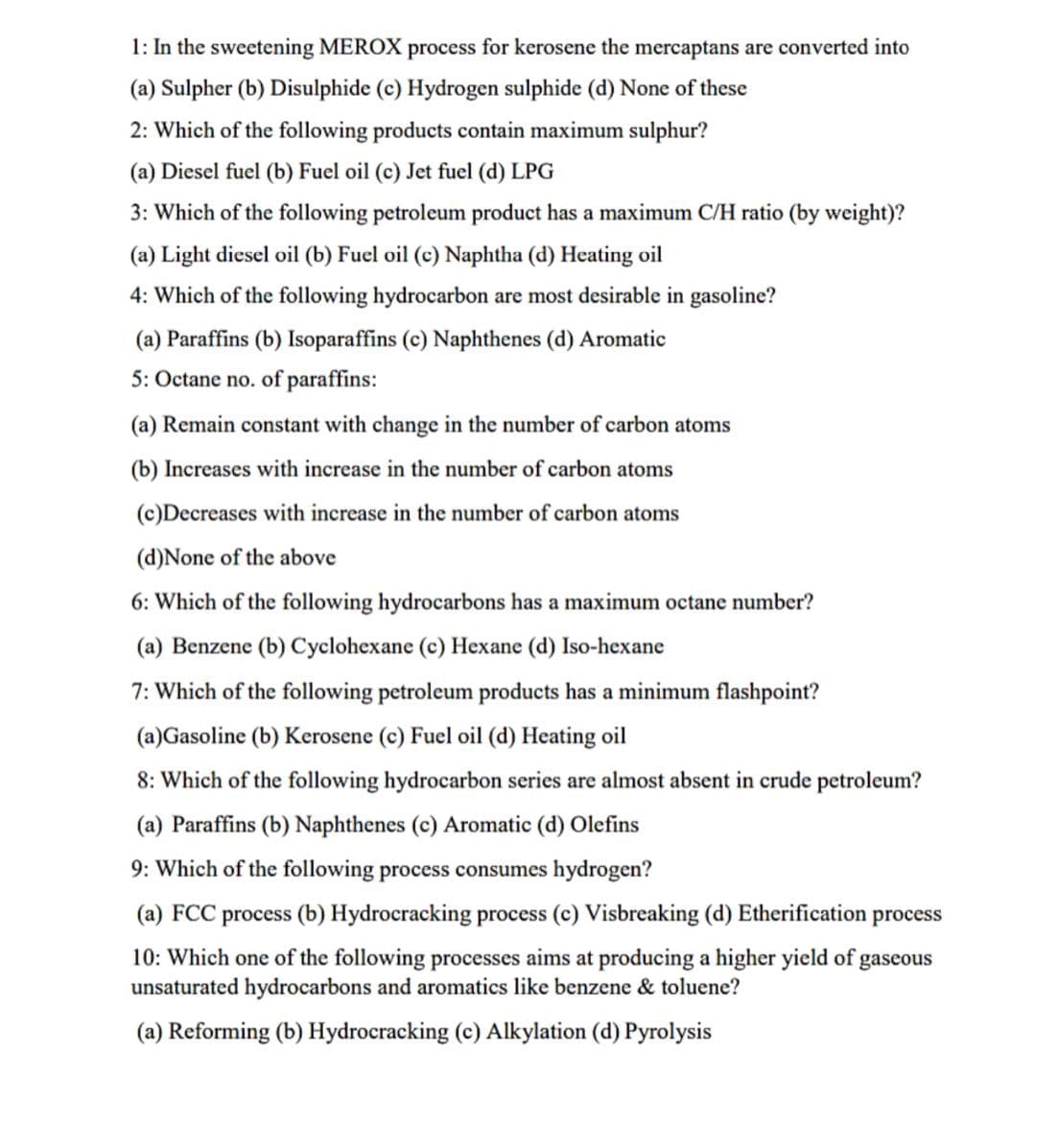5: Octane no. of paraffins: (a) Remain constant with change in the number of carbon atoms (b) Increases with increase in the number of carbon atoms (c)Decreases with increase in the number of carbon atoms (d)None of the above
5: Octane no. of paraffins: (a) Remain constant with change in the number of carbon atoms (b) Increases with increase in the number of carbon atoms (c)Decreases with increase in the number of carbon atoms (d)None of the above
Organic Chemistry
8th Edition
ISBN:9781305580350
Author:William H. Brown, Brent L. Iverson, Eric Anslyn, Christopher S. Foote
Publisher:William H. Brown, Brent L. Iverson, Eric Anslyn, Christopher S. Foote
Chapter5: Alkenes: Bonding, Nomenclature, And Properties
Section: Chapter Questions
Problem 5.31P
Related questions
Question
Solve num 5

Transcribed Image Text:1: In the sweetening MEROX process for kerosene the mercaptans are converted into
(a) Sulpher (b) Disulphide (c) Hydrogen sulphide (d) None of these
2: Which of the following products contain maximum sulphur?
(a) Diesel fuel (b) Fuel oil (c) Jet fuel (d) LPG
3: Which of the following petroleum product has a maximum C/H ratio (by weight)?
(a) Light diesel oil (b) Fuel oil (c) Naphtha (d) Heating oil
4: Which of the following hydrocarbon are most desirable in gasoline?
(a) Paraffins (b) Isoparaffins (c) Naphthenes (d) Aromatic
5: Octane no. of paraffins:
(a) Remain constant with change in the number of carbon atoms
(b) Increases with increase in the number of carbon atoms
(c)Decreases with increase in the number of carbon atoms
(d)None of the above
6: Which of the following hydrocarbons has a maximum octane number?
(a) Benzene (b) Cyclohexane (c) Hexane (d) Iso-hexane
7: Which of the following petroleum products has a minimum flashpoint?
(a)Gasoline (b) Kerosene (c) Fuel oil (d) Heating oil
8: Which of the following hydrocarbon series are almost absent in crude petroleum?
(a) Paraffins (b) Naphthenes (c) Aromatic (d) Olefins
9: Which of the following process consumes hydrogen?
(a) FCC process (b) Hydrocracking process (c) Visbreaking (d) Etherification process
10: Which one of the following processes aims at producing a higher yield of gaseous
unsaturated hydrocarbons and aromatics like benzene & toluene?
(a) Reforming (b) Hydrocracking (c) Alkylation (d) Pyrolysis
Expert Solution
This question has been solved!
Explore an expertly crafted, step-by-step solution for a thorough understanding of key concepts.
Step by step
Solved in 2 steps

Knowledge Booster
Learn more about
Need a deep-dive on the concept behind this application? Look no further. Learn more about this topic, chemistry and related others by exploring similar questions and additional content below.Recommended textbooks for you

Organic Chemistry
Chemistry
ISBN:
9781305580350
Author:
William H. Brown, Brent L. Iverson, Eric Anslyn, Christopher S. Foote
Publisher:
Cengage Learning


Chemistry: An Atoms First Approach
Chemistry
ISBN:
9781305079243
Author:
Steven S. Zumdahl, Susan A. Zumdahl
Publisher:
Cengage Learning

Organic Chemistry
Chemistry
ISBN:
9781305580350
Author:
William H. Brown, Brent L. Iverson, Eric Anslyn, Christopher S. Foote
Publisher:
Cengage Learning


Chemistry: An Atoms First Approach
Chemistry
ISBN:
9781305079243
Author:
Steven S. Zumdahl, Susan A. Zumdahl
Publisher:
Cengage Learning